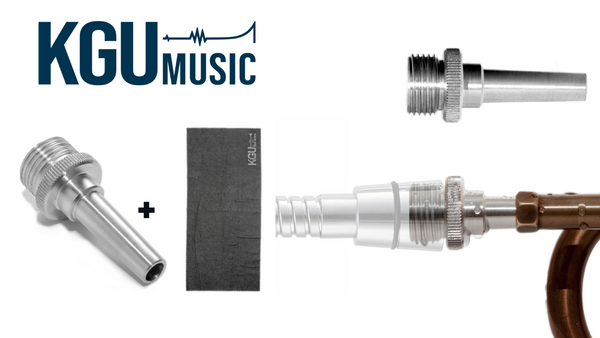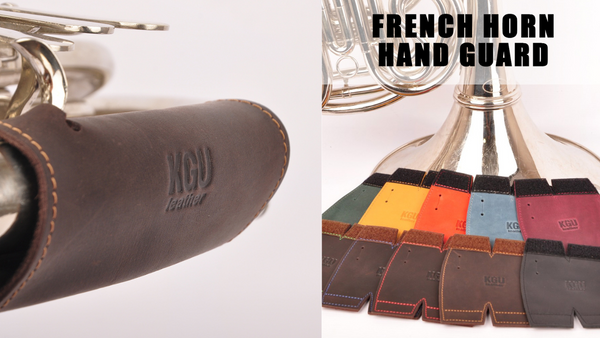French horn can delight you with many years of enjoyable use; however you should care about the instrument in the right way. The horn has slides, tubes, and rotary valves, and each component is crucial. If there's a problem with one part of the French horn, it may affect the overall instrument condition and the way it sounds, risking an impact on the entire band's sound. However, with the proper attention and care, you can avoid such unpleasant consequences and prolong the lifespan of the French horn. For this reason, we prepared a guide of how to do it.
General Rules
- Consider a separate holder, a case or a bag for keeping your instrument, as storing anything on the top of it can damage it. Choose the reliable case, able to shield the French horn from dust and moisture, and equipped with clean and dry interior.
- Keep the French horn in a stable environment with moderate temperature and humidity levels.
- Never place it in an area where there’s likehood that it will be damaged.
- Avoid playing the French horn after you’ve just eaten. Before practicing, rinse the mouth with water first. This will help to get rid of food particles, and prevent the bacteria growth on the inside of your instrument.
- If there’s a problem with your instrument, or you have your mouthpiece got stuck, don’t try to repair it yourself. Contact the specialist to avoid the serious damage.
Cleaning French Horn
It’s recommended to clean your French horn every 2–3 months to prevent corrosion and get rid of dirt accumulation.
- First, remove slides, rotary valves, and any other detachable parts.
- Prepare a lukewarm water solution (30-40 0C) with a mild soap.
- Place all the parts in soapy water and make them soak for 10 minutes. Never put the whole instrument in the water, as it can result in the dirt getting in the valves.
- Pour some running water through the leadpipe. Use the snake brush for cleaning inside the leadpipe, inserting it until it comes out the other side.
- Run the snake brush through each slide.
- If necessary, use a cloth or swab to remove excess moisture from the interior.
- After cleaning, dry each part with a soft, lint-free cloth. Make sure that no water remains in any of the tubing. As soon as all parts are dry, reassemble the French horn.
There’s another way to clean the French horn from the inside, using Aqua Nozzle. This cleaning accessory helps to remove dirt and small particles in a simple but effective way. Since it’s user-friendly, all you need is connect the Aqua Nozzle to a shower hose, insert the nozzle into the horn’s lead pipe, and turn on the water. The advantage of Aqua Nozzle is that you can even use it outdoor, in your garden, attaching it to a garden hose.
To clean the inside of the mouthpiece, use a mouthpiece brush. Rinse it under the running warm water, add a bit of soap on the brush and run it through the mouthpiece a few times. Rinse after it. The procedure of cleaning the mouthpiece should be done at least once a week.
How to Care about the Surface
To maintain the shiny look of your French horn, you need the regular cleaning. Wiping the surface with a clean, soft cloth will help to remove fingerprints, moisture, and any accumulated debris. Wipe the surface lightly with it, and make sure you don’t use abrasive materials that could damage the finish.
The next important step is polishing, using a quality brass polish. You should apply the polish with a soft cloth, trying not to apply too much pressure. Make sure you don’t apply polish too frequently, because it can wear down the lacquer over time. Never use harsh chemicals and household cleaners on the French horn, as they can damage the lacquer. Use only brass instrument cleaning and polishing products, designed for your instrument.
The regular direct contact of the hands can lead to the accumulation of the oil and acids from the skin. The impact of these factors can also cause damage to the aesthetic look of the finish. So that you should care about a proper hand protection, such as gloves or horn hand guards. Leather horn guards serve a dual purpose, since they both protect the delicate finish of the French horn and provide a comfortable grip for the musician. Designed to wrap around the most handled areas, the horn guards protect it from scratches, fingerprints, and moisture. Being durable, the leather guards serve during years. Apart from their protective feature, leather horn guards add a touch of sophistication and enhance the look of the instrument. 
How to Care about Slides and Valves?
Since even the smallest dent in the slide can affect the playability of the French horn, you should pay serious attention to caring about these parts.
- Before cleaning, the slides must be removed.
- To remove the dirt from them, use a snake-type brush and soap.
- After they have dried, grease them with slide grease. Remove one slide at a time, not to mix them up! Apply a small amount of slide grease to the inner surfaces of the slides, doing this by using your finger.
- Spread the grease evenly along the entire length of the slide. Ensure that the grease covers the inner surfaces where the slide will move.
- Install the slide, move it back and forth a few times to evenly spread the grease. This helps to create a smooth and consistent layer of lubrication.
- Wipe off excess grease.
- Slide each greased slide to ensure smooth and easy movement. If you experience any resistance, check for uneven application of grease and redistribute if necessary.
Oiling the valves of a French horn is an important part of regular maintenance. It ensures smooth and efficient playing.
- First, use valve oil specifically designed for brass instruments.
- Ensure the horn is clean and free of debris.
- Prepare the French horn, removing the valve caps carefully. If there are remnants of old oil, remove it using a clean cloth or cotton swab.
- To apply the valve oil, turn the horn upright, and with the valve depressed, apply a few drops of valve oil into the valve casing. You can do this by placing the oil dropper directly into the valve casing.
- Move the valve up and down several times to distribute oil evenly inside the valve casing.
- Use a clean cloth to wipe away excess oil on the valve and casing.
- Repeat the process for each valve.
- Once valves are oiled and wiped, place the valve caps back on securely.
- Finally, have a playing test by pressing each valve to check for smooth and responsive action.
Oil valves regularly, especially if you notice changes in valve actions.
By taking care of your French horn regularly in the right way, you ensure that your instrument remains in optimal playing condition, ready to accompany you on your way to new achievements.



 https://kgumusic.com/pages/about-us
https://kgumusic.com/pages/about-us
1 comment